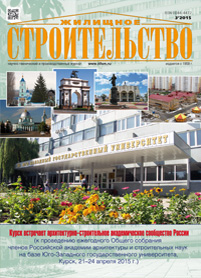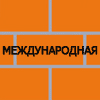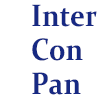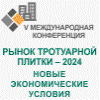Zhilishchnoe Stroitel'stvo №3

Table of contents
V.A. ILYICHEV
1
, Doctor of Sciences (Engineering), Academician of RAACS (ilyichev@mail.ru), S.G. EMELYANOV
2
, doctor of technical science, associate professor,
V.I. KOLCHUNOV
2
, doctor of technical science, associate professor, N.V. BAKAYEVA
2
, doctor of technical science, associate professor,
S.A. KOBELEVA
3
, Candidate of Sciences (Engineering)
1 Russian Academy of architecture and construction sciences (24, Dmitrovka Street, 103071, Moscow, Russian Federation)
2 Southwest state university (94, 50 let Octyabrya Street, 305040, Kursk, Russian Federation)
3 State University – Education-Science-Production Complex (29, Naugorskoe Highway, 127238, Orel, Russian Federation) Modeling and Analyzing of the Regularities the Dynamics State Change of Biosphere Compatible Urban Areas A new approach is suggested to modeling the dynamics of state change in urban areas and is based on the principles of biosphere compatibility and self- organization. Conceptual model of biosphere compatible urban areas is built in the form of a multicomponent natural and socio-technical structure. A mathematical model is developed to describe a balanced state urban areas as open dynamic structures with a choice of the governing parameters for management. As a criterion for evaluating the effectiveness of building technologies is proposed to use a generalized indicator of their environmental safety. Keywords: biosphere compatibility, urban livelihood system, simulation, mechanism of self-organization, triple balance, natural and technogenic structure
References
1. Il'ichev V.A. Biospheric compatibility – the principle, allowing to construct a life paradigm in harmony with a planet Earth. Biosfernaja sovmestimost': chelovek, region, tehnologii. 2013. No. 1, pp. 4–5. (In Russian).
2. Il'ichev V.A., Karimov A.M., Kolchunov V.I., Aleksashina V.V., Bakaeva N.V., Kobeleva S.A. Proposals to the Draft Doctrine of Urban Development and Resettlement (Strategic City Planning). Zhilishchnoe Stroitel'stvo [Housing Construction]. 2012. No. 1, pp. 2–10. (In Russian).
3. Il'ichev V.A., Malmygin I.A. Calculation of biotechnosphere humanitarian balances. Gradostroitel'stvo. 2011. No. 4, pp. 38–44. (In Russian).
4. Ilyichev V., Emelyanov S., Kolchunov V., Bakaeva N. About the Dynamic Model Formation of the Urban Livelihood System Compatible with the Biosphere. Applied Mechanics and Materials. 2015. 725–726. P. 1224–1230.
5. Il'ichev V.A., S.G. Emelyanov, V.I. Kolchunov, V.A. Gor don, N.V. Bakaeva Principy preobrazovania goroda v bio sferosovmestimij i razvivajushij cheloveka. Moscow: ASV, 2015. 184 p. (In Russian).
6. Il'ichev V.A., Kolchunov V.I., Kobeleva S.A. A criterion model of full resource cycle is a basis of ecological safety of construction. Promyshlennoe i grazhdanskoe stroitel'stvo. 2014. No. 12, pp. 3–6. (In Russian)
7. Il’ichev V.A., Karpenko N.I., Yarmakovsky V.N. About Development of Building Materials Production on the Basis of Secondary Industrial Products (SIPs). Stroitel'nye Materialy [Construction materiаls]. 2011. No. 4, pp. 36–40. (In Russian).
8. Kobeleva S.A. The systematization and identification of the directions of quality standard of the potential of energo- and resource-saving of civil buildings. Stroitel'stvo i rekonstrukcija. 2014. No. 5 (55), pp. 61–66. (In Russian).
9. Kolchunov V.I. Basic trends in developing structural designs and provision of dwelling safety. Promyshlennoe i grazhdanskoe stroitel'stvo. 2007. No. 10, pp. 12–14. (In Russian).
10. Nikolaev S.V. Social'noe zhil'e na novom jetape sovershen stvovanija. Zhilishchnoe Stroitel'stvo [Housing Construction]. 2013. No. 3, pp. 2–9. (In Russian).
11. Kobeleva S.A., Bakayeva N.V., Andreytseva C.S. Modeling of the housing sphere compatible to the biosphere. Zhilishchnoe Stroitel'stvo [Housing Construction]. 2014. No. 6, pp. 60–63. (In Russian).
12. Klueva N.V., Kolchunov V.I., Bukhtiyarova A.S. Resource energy saving structural system for residential and public buildings with a preset level of structural safety. Promyshlennoe i grazhdanskoe stroitel'stvo. 2014. No. 2, pp. 37–41. (In Russian).
13. Klueva N.V., Kolchunov V.I., Rypakov D.A., Bukhtiyaro va A.S. Durability and Deformability of Precast-Cast-in Place Frameworks for Residential Buildings with Low Material Consumption at Beyond-Design-Basis Impacts. Promyshlennoe i grazhdanskoe stroitel'stvo. 2015. No. 1, pp. 5–9 (In Russian).
1 Russian Academy of architecture and construction sciences (24, Dmitrovka Street, 103071, Moscow, Russian Federation)
2 Southwest state university (94, 50 let Octyabrya Street, 305040, Kursk, Russian Federation)
3 State University – Education-Science-Production Complex (29, Naugorskoe Highway, 127238, Orel, Russian Federation) Modeling and Analyzing of the Regularities the Dynamics State Change of Biosphere Compatible Urban Areas A new approach is suggested to modeling the dynamics of state change in urban areas and is based on the principles of biosphere compatibility and self- organization. Conceptual model of biosphere compatible urban areas is built in the form of a multicomponent natural and socio-technical structure. A mathematical model is developed to describe a balanced state urban areas as open dynamic structures with a choice of the governing parameters for management. As a criterion for evaluating the effectiveness of building technologies is proposed to use a generalized indicator of their environmental safety. Keywords: biosphere compatibility, urban livelihood system, simulation, mechanism of self-organization, triple balance, natural and technogenic structure
References
1. Il'ichev V.A. Biospheric compatibility – the principle, allowing to construct a life paradigm in harmony with a planet Earth. Biosfernaja sovmestimost': chelovek, region, tehnologii. 2013. No. 1, pp. 4–5. (In Russian).
2. Il'ichev V.A., Karimov A.M., Kolchunov V.I., Aleksashina V.V., Bakaeva N.V., Kobeleva S.A. Proposals to the Draft Doctrine of Urban Development and Resettlement (Strategic City Planning). Zhilishchnoe Stroitel'stvo [Housing Construction]. 2012. No. 1, pp. 2–10. (In Russian).
3. Il'ichev V.A., Malmygin I.A. Calculation of biotechnosphere humanitarian balances. Gradostroitel'stvo. 2011. No. 4, pp. 38–44. (In Russian).
4. Ilyichev V., Emelyanov S., Kolchunov V., Bakaeva N. About the Dynamic Model Formation of the Urban Livelihood System Compatible with the Biosphere. Applied Mechanics and Materials. 2015. 725–726. P. 1224–1230.
5. Il'ichev V.A., S.G. Emelyanov, V.I. Kolchunov, V.A. Gor don, N.V. Bakaeva Principy preobrazovania goroda v bio sferosovmestimij i razvivajushij cheloveka. Moscow: ASV, 2015. 184 p. (In Russian).
6. Il'ichev V.A., Kolchunov V.I., Kobeleva S.A. A criterion model of full resource cycle is a basis of ecological safety of construction. Promyshlennoe i grazhdanskoe stroitel'stvo. 2014. No. 12, pp. 3–6. (In Russian)
7. Il’ichev V.A., Karpenko N.I., Yarmakovsky V.N. About Development of Building Materials Production on the Basis of Secondary Industrial Products (SIPs). Stroitel'nye Materialy [Construction materiаls]. 2011. No. 4, pp. 36–40. (In Russian).
8. Kobeleva S.A. The systematization and identification of the directions of quality standard of the potential of energo- and resource-saving of civil buildings. Stroitel'stvo i rekonstrukcija. 2014. No. 5 (55), pp. 61–66. (In Russian).
9. Kolchunov V.I. Basic trends in developing structural designs and provision of dwelling safety. Promyshlennoe i grazhdanskoe stroitel'stvo. 2007. No. 10, pp. 12–14. (In Russian).
10. Nikolaev S.V. Social'noe zhil'e na novom jetape sovershen stvovanija. Zhilishchnoe Stroitel'stvo [Housing Construction]. 2013. No. 3, pp. 2–9. (In Russian).
11. Kobeleva S.A., Bakayeva N.V., Andreytseva C.S. Modeling of the housing sphere compatible to the biosphere. Zhilishchnoe Stroitel'stvo [Housing Construction]. 2014. No. 6, pp. 60–63. (In Russian).
12. Klueva N.V., Kolchunov V.I., Bukhtiyarova A.S. Resource energy saving structural system for residential and public buildings with a preset level of structural safety. Promyshlennoe i grazhdanskoe stroitel'stvo. 2014. No. 2, pp. 37–41. (In Russian).
13. Klueva N.V., Kolchunov V.I., Rypakov D.A., Bukhtiyaro va A.S. Durability and Deformability of Precast-Cast-in Place Frameworks for Residential Buildings with Low Material Consumption at Beyond-Design-Basis Impacts. Promyshlennoe i grazhdanskoe stroitel'stvo. 2015. No. 1, pp. 5–9 (In Russian).
N.I. KARPENKO, Doctor of Sciences (Engineering) (niisf_lab9@mail.ru), S.N. KARPENKO, Doctor of Sciences (Engineering) Research Institute for Building Physics of RAASN (21, Lokomotivny Passage, 127238, Moscow, Russian Federation) About Formation of Physical Ratios for Concrete Elements Under Volumetric Stress State in Increments The construction of physical dependencies between finite increments (∆σb1, ∆σb2, ∆σb3) of principal stresses (σb1, σb2, σb3) and increments (∆εb1, ∆εb2, ∆εb3) of main strains (εb1, εb2, εb3) under the volumetric stress state on the load steps is considered. The method of construction is reduced to the determination of coefficients of flexibility matrix at increments due to specially defined differences of analogous compliances in physical dependences connecting total main stresses (σb1, σb2, σb3) with main strains (εb1, εb2, εb3) in the end and beginning of the load step. At that, the method of construction of physical ratios in increments, which has been developed in [1] for the plane stress state, is evolving. As it is shown in [2, 3] the use of physical ratios in increments makes it possible to significantly reduce the number of iterations and, in certain cases, to use the non-iteration method for calculation of various complex reinforced concrete structures with due regard for factors of physical non-linearity of concrete. Keywords: volumetric stress state, triaxial compression, compression-tension cases, triaxial tension, main stresses, main relative strains, increment of stresses and strains, connection between stress and strains and their increments (physical ratios), formation of flexibility matrix. References
1. Karpenko S.N. About creation of the general method of calculation of ferroconcrete flat designs in final increments. Beton i zhelezobeton. 2005. No. 3, рр. 22–26. (In Russian).
2. Karpenko S.N. Methods of the solution of physically nonlinear problems of reinforced concrete in final increments. Izvestiya Orlovskogo gosudarstvennogo tekhnicheskogo universiteta. Seriya Stroitel'stvo i transport. 2009, No. 6, pp. 9–14. (In Russian).
3. Karpenko N.I., Karpenko S.N., Petrov A.N., Palyuvina S.N. Model' deformirovaniya zhelezobetona v prirashcheniyakh i raschet balok–stenok i izgibaemykh plit s treshchinami [Model of deformation of reinforced concrete in increments and calculation of beams walls and the bent plates with cracks]. Petrozavodsk: Petrozavodsk state university, 2013. 153 p. (In Russian).
4. Karpenko N.I., Karpenko S.N. Compound criterion of durability of concrete at a volume tension. Concrete and reinforced concrete – a prospection. Trudy III Vserossiiskoi i II Mezhdunarodnoi konferentsii po betonu i zhelezobetonu [Works III of the All-Russian and II International conference on concrete and reinforced concrete]. Moscow: MISI–MGSU, 2014. V. IV, рр. 156–165. (In Russian).
5. Karpenko N.I. Obshchie modeli mekhaniki zhelezobetona [General models of mechanics of reinforced concrete]. M.: Stroyizdat, 1996, pp. 60–91. (In Russian).
6. Karpenko N.I., Sokolov B.S., Radaykin O.V. The analysis and improvement of curvilinear charts of deformation of concrete for calculation of ferroconcrete designs for deformativny model. Promyshlennoe i grazhdanskoe stroitel'stvo. 2003. No. 1, рр. 28–30. (In Russian).
7. Kupfer H.B. Das nicht – lineare Venhalten des Betons bei zw eiachte-ider Beanspruchung. Beton und – Stahlbetonbau. 1973. No. 11, рр. 269–274.
A.T. DVORETSKY, Doctor of Sciences (Engineering) (dvoretskyat@ukr.net), K.N. KLEVETS, Engineer, D.A. DVORETSKY, Engineer Crimean Federal University named after V.I. Vernadsky (4, Vernadskogo Street, 295033, Simferopol, Russian Federation) Energy-Efficient Architecture of Buildings in Mixed Climate A main factor influencing on the architecture of energy-efficient buildings is the climate. Peculiarities of the climate in Crimea, which can be attributed to the mixed type with cold winter and hot summer, are analyzed. At that, the architecture of energy-efficient buildings of the mixed climate must have the characteristics of two types: with a predomination of summer climate and with a predominance of winter climate but not conflicting with each other. In this regard, the improvement and development of the typology of buildings with due regard for energy efficiency is actual. The characteristics of energy-efficient buildings are analyzed; recommendations on shaping of the building envelope, the use of designs and devices for cooling the building during the hot period of the year and heating, including passive one, during the cold period of the year aimed at improving the energy efficiency of buildings in the mixed climate are made. Keywords: energy efficiency, energy-efficient building, architecture, resource saving, mixed climate, typology, passive heating, shading device. References
1. Ilyichev V.A., Kolchunov V.I., Emelyanov S.G., Bakaeva N.V. Social Expectations, Housing Programs and Quality of Life on Urbanized Areas. Promyschlennoe I Grazhdanskoe Stroitel’stvo. 2014. No. 2, рp. 3–7. (in Russian).
2. Ilyichev V.A., Karimov A.M., Kolchunov V.I., Aleksashina V.V., Bakaeva N.V., Kobeleva S.A. Proposals to the Draft Doctrine of Urban Development and Resettlement (Strategic City Planning). Zhilishchnoe Stroitel'stvo [Housing Construction]. 2012. No. 1, pp. 2–10. (In Russian).
3. Sergeychuk O.V. Optimization of the Form of Energy Conservation Buildings. Motornizacja i energetyka rolnictwa. Lublin, 2008. No. 10A, pp. 121–130. (In Russian).
4. Umnyakova N.P., Butovskiy I.N., Chebotarеv A.G. Development of the Regulation Methods of Heat Shield of Energy Efficient Buildings. Zhilishchnoe Stroitel'stvo [Housing Construction]. 2014. No. 7, pp. 19–23. (In Russian).
5. Feist V. Summary of designing passive houses. Moscow: ASB, 2008. 144 p.
6. Beregovoi A.M., Proshin A.Р., Beregovoi V.А. Energy Saving in Architecture Design. Zhilishchnoe Stroitel’stvo [Housing Construction]. 2002. № 5, pp. 4–6. (In Russian).
7. Dvoretsky A.T. Influence of Solar Radiation on the Duration of the Heating Period and the Period of Cooling of Buildings in Crimea. Biosfernaja Sovmestimost’. Chelovek, Region, Tehnologija. 2014. No. 3 (7), pp. 74–80. (In Russian).
8. Dvoretsky A.T., Klevets K.N. Analysis of the Impact of Different Types of Glazed Veranda on the Heat Balance of the Energy-Efficient Home. Stroitel’stvo i Reconstrukcija. 2014. No. 5 (55), pp. 54–59. (In Russian).
9. Dvoretsky A.T., Dvoretsky D.A. Solar Energy of Greenhouse in Heat Balance of Small Building. Stroitel’stvo i Tehnogennaja Bezopasnost’. Collection of scientific papers. 2012. No. 41, pp. 14–19. (In Russian).
N.V. KLYuEVA, Doctor of Sciences (Engineering) (klynavit@yandex.ru), D.A. RIPAKOV, Engineer (rypakov89@mail.ru) Southwest State University (94, 50 let Oktyabrya Street, Kursk, 305040, Russian Federation) Calculation of Dynamic Added Stresses in Reinforced Concrete Elements Working in Bending with Twisting in the Course of Fracturing The methods for calculation of dynamic added stresses when cracks are forming in pre-stressed reinforced concrete elements working in bending with twisting are proposed. It is shown that at the time of destruction of concrete along the spatial spiral crack, longitudinal oscillations of the reinforcement bar and, accordingly, longitudinal dynamic forces are generated in stretched reinforcement. It is proposed to determine the numerical value of this force during the first half-wave of oscillations on an energy base. The presented calculation methodology can be used for the assignment of the controlled preliminary stress in pre-stressed reinforced concrete elements as well as for the calculation of durability parameters of reinforced concrete frame-bar structural systems of buildings and structures under the beyond design conditions. Keywords: twisting with bending, crack formation, dynamic added stress. References
1. Kolchunov V.I., Androsova N.B., Klyueva N.V., Bukhtiyaro va A.S. Zhivuchest' zdanii i sooruzhenii pri zaproektnykh vozdeistviyakh [Survivability of buildings and structures at the design basis impacts]. Moscow: ASV, 2014. 208 p.
2. Gordon V.A., Klyueva N.V., Poturaeva T.V., Bukhtiyaro va A.S. Raschet dinamicheskikh usilii v konstruktivno nelineinykh elementakh sterzhnevykh prostranstvennykh sistem pri vnezapnykh strukturnykh izmeneniyakh. Stroitel'naya mekhanika i raschet sooruzhenii. 2008. No. 6, pp. 26–30. (In Russian).
3. Kolchunov V.I., Kudrina D.V. Eksperimental'no-teoreticheskie issledovaniya prednapryazhennykh zhelezobetonnykh elementov ram v zapredel'nykh sostoyaniyakh. Stroitel'naya mekhanika i raschet sooruzhenii. 2010. No. 3, pp. 14–17. (In Russian).
4. Kolchunov V.I., Safonov A.G. Postroenie rascheta zhelezobetonnykh konstruktsii na kruchenie s izgibom. Izvestiya Orlovskogo gosudarstvennogo tekhnicheskogo universiteta. 2008. No. 4, pp. 7–13. (In Russian).
5. Kolchunov V.I., Safonov A.G., Kolchunov Vl.I. Praktiche skii uchet kontsentratsii uglovykh deformatsii v zone sopryazheniya rebra s polkoi zhelezobetonnykh obvyazochnykh rigelei pri kruchenii s izgibom. Stroitel'naya mekhanika i raschet sooruzhenii. 2009. No. 2, pp. 6–10. (In Russian).
6. Kolchunov V.I., Klyueva N.V., Kolchunov Vl.I., Yakoven ko N.A. Problemnye zadachi razvitiya gipotez mekhaniki razrusheniya primenitel'no k raschetu zhelezobetonnykh konstruktsii. Izvestiya Kazanskogo gosudarstvennogo arkhitekturno-stroitel'nogo universiteta. 2014. No. 3, pp. 41–45. (In Russian).
7. Bashirov Kh.Z., Gornostaev I.S., Kolchunov V.I., Yakoven ko N.A. Napryazhenno-deformirovannoe sostoyanie zhelezo betonnykh sostavnykh konstruktsii v zone normal'nykh treshchin. Stroitel'stvo i rekonstruktsiya. 2013. No. 2, pp. 11–19. (In Russian).
8. Bondarenko V.M., Kolchunov V.I. Raschetnye modeli silovogo soprotivleniya zhelezobetona [Computational models of the power of resistance of reinforced concrete]. Moscow. ASV. 2004. 474 p.
M.A. KALITINA, Candidate of Sciences (Engineering) (mkalitina@bk.ru), A.V. KAZMINA, Candidate of Sciences (Pedagogic), F. F. ARSLANBEKOVA, Candidate of Sciences (Biological) Russian State Social University (4/1, Vilgelm Pick Street, Moscow, 129226, Russian Federation) Influence of complex multicomponent additives on properties of a cement stone and concrete This article presents the effect of complex multicomponent additives based on traditional superplasticizer C-3 and superplasticizer new generation of polycarboxylate based on the properties of cement stone and concrete. It was found that the combined use in complex superplasticizers additives, inorganic electrolyte and microsilica, have a good compatibility mechanisms of their influence on the processes of hydration, hydrate formation and structures of cement hardening, complement and reinforce the effect of each ingredient additive that allows the targeted form the structure of cement paste, work on a set of properties cementitious materials in the desired degree of increasing their quality and technological parameters. It is shown that the use of complex additives with polycarboxylate superplasticizers allows to obtain more concrete with high performance. Keywords: multicomponent additives, superplasticizers, polycarboxylates, microsilica, cement hydration. References
1. Dobshits L.M., Kononova O. V., Anisimov S.N., Leshka nov A.Y. Influence the polycarboxylate superplasticizers on structurization of cement pastes. Fundamental'nye Issledovaniya. 2014. No. 5–5, pp. 945–948. (In Russian).
2. Seskin I.I, Baranov A.S. Influence of superplasticizer C-3 on formation of strength of pressed concrete. Stroitel'nye Materialy [Construction materiаls]. 2013. No. 9, pp. 32–33. (In Russian).
3. Izotov V. S., Ibragimov R. A. Influence of a new complex additive on the main properties of cement compositions. Stroitel'nye Materialy. 2012. No. 6, pp. 63–64. (In Russian).
4. Selyaev V.P., Neverov V.A., Kupriyashkina L.I., Mash taev O.G. Natural and artificial micro-silica as fillers for vacuum Insulation panels. Stroitel'nye Materialy [Construction materiаls]. 2014. No. 10, pp. 60–61. (In Russian).
5. Lothenbach B., Winnefeld F., Figi R. The influence of superplasticizers on the hydration of Portland cement. Proceedings of the 12th International Congress on the Chemistry of Cement. Montreal. 2007, pp. 211–233.
6. Koizumi K., Umemura Y., Tsuyuki N. Effects of Chemical Admixtures on the Silicate Structure of Hydrated Portland Cement. Proceedings of the 12th International Congress on the Chemistry of Cement. Montreal. 2007, pp. 64–71.
7. Gamaliy E.A., Trofimov B.J., Kramar L.Y. Structure and properties of cement paste with the addition of silica fume and polycarboxylate plasticizer // Vestnik YuUrGU. Seriya «Stroitel'stvo i arkhitektura». 2009. Vol. 8. No. 16 (149), pp. 29–35. (In Russian).
8. Kalashnikov V.I., Moroz M.N., Tarakanov O.V., Kalash nikov D.V., Suzdaltsev O.V. New ideas about action mechanism of superplasticizers grinded jointly with cement or mineral rocks. Stroitel'nye Materialy [Construction materiаls]. 2014. No. 9, pp. 70–71. (In Russian).
9. Sorvacheva Yu.A., Petrova T.M., Giebson C., Fedchen co A.A. Influence of polycarboxylate based superplasticizers on the alkali-silica expansion of the concrete. Stroitel'nye Materialy [Construction materiаls]. 2014. No. 5, pp. 15–16. (In Russian).
10. Usherov-Marshak A.V. Khimicheskie i mineral'nye dobavki v beton [Chemical and mineral additives in concrete]. Kharkov: Color. 2005. 281 p.
11. Guvalov A.A., Kabus A.V. Usherov-Marshak A.V. Influence of an organo-mineral additive on early hydration of cement. Stroitel'nye Materialy [Construction materiаls]. 2013. No. 9, pp. 95–96. (In Russian).
S.V. ILVITSKAYA 1 , Doctor of Architecture, A.V. SMIRNOV 2 , Architect (asldot@yandex)
1 State University of Land Use Planning (15, Kazakova Street. 105064, Moscow, Russian Federation)
2 Russian International Academy for Tourism (10, Oktyabrskaya Street, micro-district Skhodnya, Khimki, 141420, Moscow region, Russian Federation) Role of Cultural-Leisure Centers in Preservation of Cultural Heritage Objects Issues of the preservation of the historical-architectural heritage, existing variants of organization of necessary functional processes on its base, which meet the modern needs of the population, are considered. It is shown that one of the basic possibilities to involve objects of historical-cultural heritage in the life of the Russian society is connected with the development of cultural tourism. To attract tourists successfully, besides the main museum-exhibition function of the heritage object the most common in domestic practice, it is necessary to create the developed touristic infrastructure. This imposes the contemporary requirements for the cultural-leisure infrastructure of environment surrounding the object of historical-architectural heritage. On the concrete example, the possibility of integration of historical-architectural objects of the heritage in the life of Russian society by means of creation, on their base, of new multifunctional cultural-leisure centers as centers of attraction of tourists and local population is shown. Keywords: object of historical-architectural heritage, historical environment, cultural tourism, cultural-leisure center. References
1. Lazarev A.G. Possible ways to preserve the architectural and historical and cultural heritage. Zhilishchnoe Stroitel'stvo [Housing Construction]. 2010. No. 10, pp. 8–11. (In Russian).
2. Dolgova V.O. The problem of preservation of architectural and landscape features of culture and historical heritage in the small cities of Russia. Gradostroitel'stvo. 2013. No. 4, pp. 73–77. (In Russian).
3. Grintsevich E.A. Assessment of the economic potential of architectural cultural heritage. Ekonomika i predprinima tel'stvo. 2011. No. 5, pp. 122–124. (In Russian).
4. Esaulov G.V. Results of scientific and creative activity RAASN from 2009 for 2013. Gradostroitel'stvo. 2014. No. 3 (31), рр. 18–22. (In Russian).
5. Sapacheva L.V. Discussion of the new scientific direction by scientific community – geonicknames. Stroitel'nye Materialy [Construction materiаls]. 2013. No. 10, pp. 44–45. (In Russian).
6. Grishina O.A., Grishin A.I. Iistoriko-cultural heritage in the context of a sustainable development. Vestnik Rossiiskogo ekonomicheskogo universiteta im. G.V. Plekhanova. 2012. No. 5, рр. 16–24. (In Russian).
7. Kuderskaya N.I. Legal aspects of protection of architectural and town-planning heritage. Voprosy rossiiskogo i mezhdu narodnogo prava. 2011. No. 2, рр. 128–149. (In Russian).
N.K. KAPUSTYAN 1,2 , Doctor of Sciences (Physics and Mathematics) (nkapustian@gmail.com), G.N. ANTONOVSKAYA 1 , Candidate of Sciences (Engineering), A.N. KLIMOV 2 , Engineer, I.M. BASAKINA 1 , Candidate of Sciences (Engineering)
1 Institute of Ecological Problems of the North, Ural Branch, Russian Academy of Sciences (23, Northern Dvina River Embankment, 163000 Arkhangelsk, Russian Federation)
2 Central Research and Design Institute for Residential and Public Buildings (TSNIIEPzhilishcha) (9, structure 3, Dmitrovskoye Highway, 127434, Moscow, Russian Federation) Evaluation of Strong Seismic Impacts on Buildings According to Observations of Weak Vibrations On the basis of experimental examples, the possibility of forecasting strong seismic impacts (earthquakes, piling) on the existing building or the building under designing is presented. The methodology includes recording of accelerograms of weak “trial” impacts (shocks, transport vibrations), execution of dynamic analysis with the subsequent recalculation of values. Keywords: vibro-impacts, self-induced vibrations, dynamic analysis. References
1. Kurbatsky E.N., Bayev L.V. Ranges Of The Maximum Reac tions (Responses) Of Designs To Seismic And Technogenic Dynamic Influences. Seysmostoykoe Stroitel'stvo. Bezopast nost soorujeniy. 2012. No. 1, pp. 37–42. (In Russian).
2. Ordynskaya A.P. An Integrated Assessment Of Intensity Of Manifestations Of Earthquakes In Environment And A Technosphere. Seysmostoykoe Stroitel'stvo. Bezopastnost soorujeniy. 2010. No. 5, рр. 45–53. (In Russian).
3. Smirnov V.I., Vakhrina G.N. Development Of Models Settlement Accelerogram Seismic Influences. Seysmostoykoe Stroitel'stvo. Bezopastnost soorujeniy. 2011. No. 4, рр. 26–34. (In Russian).
4. Having Prevailed Upon V.I. Tool Supervision Of Seismic Manifestations Of East Carpathian Earthquakes In The Ter ritory Of Moscow. Seysmostoykoe Stroitel'stvo. Bezopast nost soorujeniy. 2009. No. 3, рр. 34–42. (In Russian).
5. Antonovskaya G.N., Kapustyan N.K., Basakina I.M., Kli mov A.N. Kartina of dynamics of constructions and calculations. Seismological researches in the arctic and subarctic regions [Kartina dinamiki sooruzhenij i raschety. Sejsmologicheskie issledovanija v arkticheskih i priarkticheskih regionah]. Yekaterinburg: Ouro rahn, 2011. рр. 154–168. (In Russian).
6. Kapustyan N.K., Antonovskaya G.N., Basakina I.M., Pudo va I.V. Seismometric Methods Of Definition Of A Condition Of Constructions And A Permissible Load From Vibration Effects. Zhilishchnoe Stroitel'stvo [Housing Construction]. 2013. No. 9, pp. 30–33. (In Russian).
7. Kapustyan N.K., Antonovskaya G.N., Klimov A.N. High-Rise Buildings: Experience Of Monitoring And A Way Of Its Use At Design. Zhilishchnoe Stroitel'stvo [Housing Construction]. 2013. No. 11, pp. 6–12. (In Russian).
8. Aptikayev F.F., Rteleva O.O. Generation Artificial accelero gram By Method Of Scaling Of Real Records. Fizika Zemli. 2002. No. 7, рр. 39–45.
M.S. ZAKHAROV, Candidate of Sciences (Geology and Mineralogy) (zhmike@mai.ru) National Open Institute (6, Sestroretskaya Street, 197183, Saint Petersburg, Russian Federation) Strategy of Innovative Development of Construction Complex of the Russian Federation for the Period until 2020 and Problems of Engineering Surveys An analysis of the Strategy of innovative development of the building industry of Russia until 2020 has been made. Main goals of the Strategy concerning, first of all, the complex of engineering surveys have been selected. The inseparable connection of the entire triad of construction industry – investigations, design and construction – is shown. Main problems of the survey community under current social-economic conditions are determined. The hope for positive development of the country economy and solution of fundamental tasks set in the Strategy is expressed. Keywords: strategy, innovative development, engineering surveys for construction, normative documents, Customs Union, Eurocodes, higher construction education, construction risks, Information system “Construction”, geological funds, self-regulation, conditioning of buildings and structures, information simulation, 3D-technologies, geospatial information, expertise of survey materials.
 |
 |
 |
 |
 |
 |
 |
